A Dutch Prince, His American Jeep, and Two Female Passengers
Dutch-American Stories #16
by Written by Dik van der Meulen
During the Second World War, the English secret service did not trust the German-born Prince Bernhard of Lippe-Biesterfeld, son-in-law of Queen Wilhelmina of the Netherlands. Yet he was wildly popular among the Dutch population suffering under the Nazi yoke. So much so that he could get away with a few missteps.
In the fall of 1944, the immediate future of many people in The Netherlands looked distinctly grim. Following the Allied invasion in Normandy in June, France, as well as Belgium and southern parts of The Netherlands, had been liberated quickly. In early September spirits had been high, as many Dutchmen expected the speedy arrival of Allied forces and a quick end to the Nazi occupation of The Netherlands. But the Allied advance in Northwestern Europe stalled after the disastrous Battle of Arnhem. The Dutch provinces north and east of the Rhine and Meuse remained occupied by Nazi forces. The next winter would be very tough for the entire population, much tougher than the four preceding wartime winters. Hopes were dashed and Nazi oppression increased, resulting in retaliatory measures after armed attacks by the Dutch resistance. In late September, a botched assault on a military vehicle near Putten killed two Wehrmacht officers. General Friedrich Christiansen, the commander of the German army in The Netherlands, ordered the forced evacuation of the village. Fifty houses were torched and over six hundred male inhabitants were transported to concentration camps. Fewer than fifty returned. This was retaliation on an unprecedented scale, spreading a sense of dread throughout the occupied provinces. In addition, the Dutch feared the threat of famine. In September the Dutch government in exile, anticipating a speedy end to the war, had called for a general rail strike. When railway workers answered the call, the Nazis cut off the transport of food and fuel, especially to the coastal provinces in the west of the country. Over the course of the cold winter months, shortages began to increase, soup kitchens were set up to help those worst off, and people engaged in long treks to find food.

The Dutch government in exile was very concerned at the food shortages in the occupied provinces. And so was Prince Bernhard. In early September 1944, Queen Wilhelmina had ensured his appointment as commander of the Binnenlandse Strijdkrachten (Domestic Armed Forces), a recent union of several previously separate Dutch resistance groups. Bernhard’s leadership was stained by controversy, as he proved unable to fully control the forces under his command. The Domestic Armed Forces quickly acquired a bad reputation for unruly behavior and occasionally resorted to pillage and plundering. As Bernhard did not publicly distance himself from unsavory incidents, he suffered some reputational damage as a result. Yet his concern for his starving countrymen was sincere. In November 1944, he alerted the American General Walter Bedell Smith:
The food situation in all liberated areas of Holland is very bad, and the people are on just over one half of the amount of food that they had under German occupation which was then considered by everybody as the absolute minimum.
Bernhard’s worries extended to those parts of the Netherlands that would remain occupied for many months. In April 1945, Bernhard appealed to Allied leaders to provide succor for the starving Dutch through food drops in occupied territory, in a military action called Operation Manna. Bernhard’s role in the droppings obviously enhanced his reputation. Yet it was hardly the full story of what the Prince was up to during the last phase of the war.
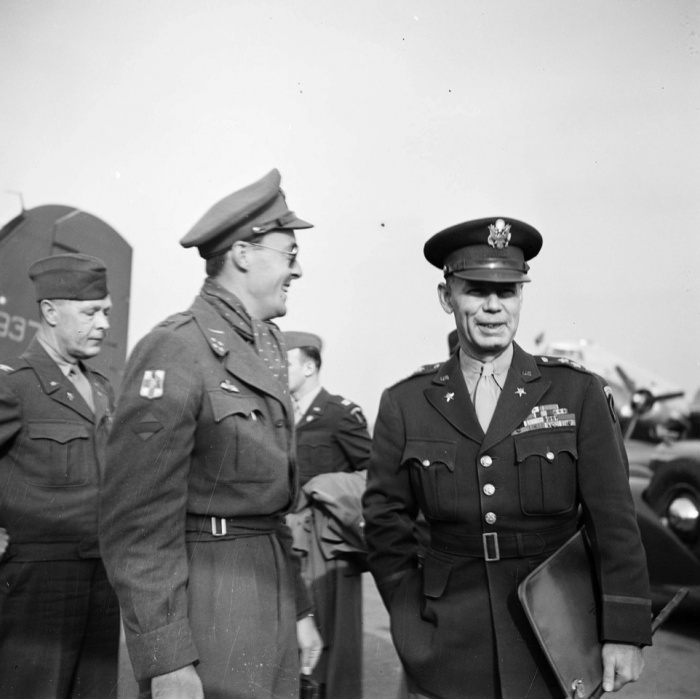
Enjoying the War
Even before Bernhard was put in charge of the Domestic Armed Forces rumors about his licentious lifestyle circulated in London. His decision to remain in the British capital in late Spring 1940, when his wife and their baby daughters moved to safety in Canada, had raised a few eyebrows. But then, Queen Wilhelmina had also decided to stay in London and she could use his support. However, it was publicly known in the Dutch community in London that other matters also took up some of the Prince’s time. “Of all the people I know, Prince Bernhard was the only one who enjoyed the war,” King George VI reputedly said. Although the story is probably apocryphal, it reveals how other Allied leaders thought of Bernhard. He found enjoyment in wartime by seeking the company of selected ladies from London society, including Lady Ann Orr-Lewis. This was a dalliance the Prince did not try to hide. Even Princess Juliana had heard about it in faraway Canada and she was hardly happy. The rumors did not stop there. In 1941, an English tabloid carried the news that Bernhard had been spotted in a dance establishment. The Prince issued a denial and demanded a rectification. Yet the following year, Jan van Angeren, the Dutch Minister of Justice, scribbled a brief remark on a letter he had just received: “Chatter about the Prince in the bars of Bayswater.” Bar gossip about Bernhard could do harm, especially in wartime, when he was supposed to keep up the spirits among the Dutch in London.
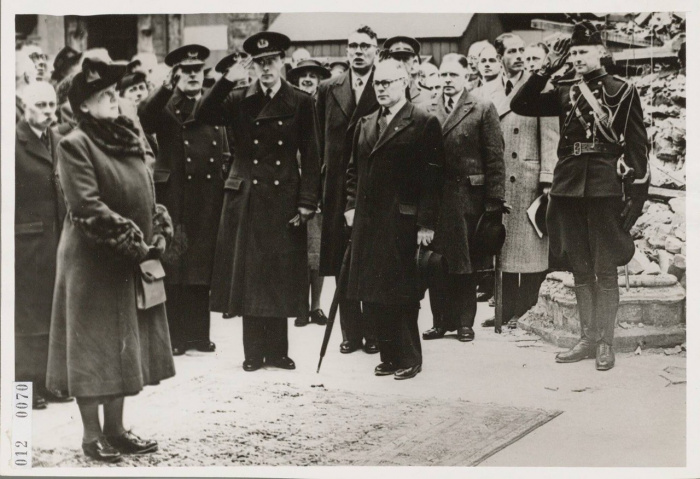
In the fall of 1944, new stories about Bernhard were doing the rounds, less serious, but at least as detrimental to the reputation of the commander of the Domestic Armed Forces. On September 6th, when most of France and Belgium had been liberated, the Prince and his staff crossed the English Channel by plane to set up his headquarters in Château Wittouck, a stately home south of Brussels. Formerly the house of the Belgian fascist politician Léon Degrelle, it provided the luxury surroundings that Bernhard had a penchant for, including a well-furnished wine cellar.
One of the regular visitors to Wittouck was Christiaan Lindemans, a member of the Dutch resistance, known for his reckless actions. His heavy built and waddling gait gained him the nickname King Kong, after the giant gorilla of the 1933 American movie. Lindemans managed to gain the trust of the Allies, including Prince Bernhard who offered him a position on his staff. Suddenly, in October 1944, Lindemans was arrested at Wittouck on suspicion of spying for the Nazis. Subsequent investigations proved that King Kong was in fact a double agent, crossing the frontline undercover to convey information to his German handlers. The extent of his treason remained unknown for a long time. Did his actions contribute to the failure of Operation Market Garden, the attempt to capture the bridge over the river Rhine at Arnhem? The German army thwarted the Allied advance across the Rhine, thus prolonging the war in northwestern Europe by eight months. And if the information provided by Lindemans was crucial, was his access to Bernhard’s HQ critical? Postwar historical research was inconclusive, although with the benefit of hindsight the Allied’s daring aim to take the Rhine bridge was doomed from the start.
A Nice Day Out
Prince Bernhard frequently made trips from Wittouck, as those involved recounted after the war. Decades later, former staff member Gijs de Jong delighted audiences with juicy tales about the forays he had made with the Prince in his Jeep through the liberated parts of the Netherlands in search of various forms of entertainment, far away from prying eyes. Details and documents about these expeditions are rare, but a set of records of the Dutch Ministry of Foreign Affairs provides a rare insight on the Prince’s trips, including the reaction of the American and Dutch authorities. On October 18th, 1944, N.A.C. Slotemaker de Bruïne, the director of the Netherlands Information Bureau (NIB) in New York, reported a rumor that had jolted him and his staff into action. It was the job of the NIB, founded in 1941 by the Dutch government in exile, to provide the American government and people with reliable information about The Netherlands. Engaging in ‘public diplomacy’ also involved countering news that was not ‘fit to print’, according to the Dutch government in exile. The memo of Slotemaker suggests that during one of his expeditions the Prince had ventured a little too close to enemy lines. Gijs de Jong was not one of the passengers on this occasion. However, it did appear Bernhard was not without company. Unfortunately, the International News Service (INS), an American news agency, had picked up a rumor in London:
According to well-known sources in London, Prince Bernhard of the Netherlands, Commander of the Dutch Army of National Liberation, was arrested by American military police for travelling without authorization along the front in Holland. The Prince, riding in a jeep, was accompanied by two women, one of them was identified as Mrs. William Fiske, formerly the Countess of Warwick.
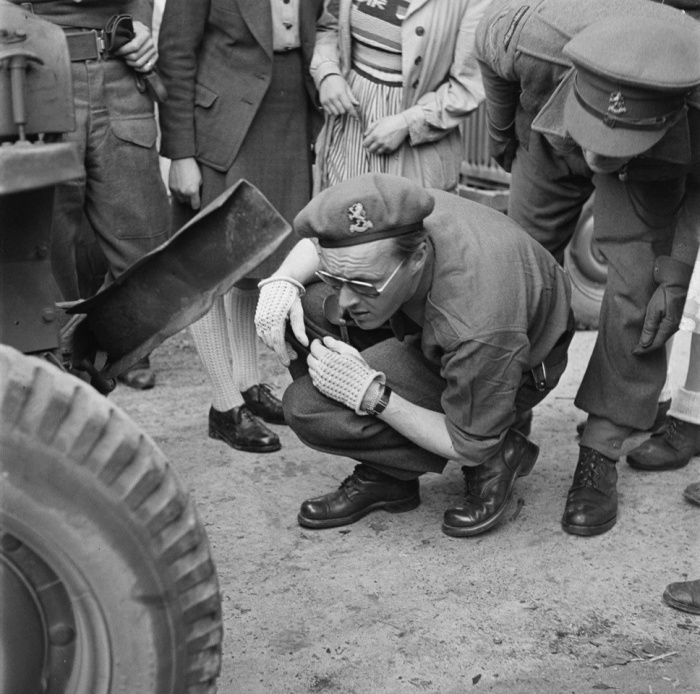
Slotemaker and his staff immediately swung into action. Communication with the Dutch Embassy in Washington revealed that the INS had already spread the news. The source was also mentioned: the British Daily Mail. Yet the London newspaper had decided not to run the story, nor did any other papers in the United Kingdom. The Embassy then contacted the Dutch government in London. The Dutch Minister of Foreign Affairs asserted that the story was completely new to him and that he considered it unlikely as the Government in London would most certainly have been informed if an incident such as was cabled from London had occurred.
In order to prevent further reputational damage to the Prince, the INS had to be informed, however “without creating the impression that the N.I.B. was trying to influence I.N.S.” Through an intermediary Slotemaker related what the Dutch considered the truth to a Mr. Zepp at the INS. In response, Zepp indicated that the “additional information” from the Dutch government in London would be used if it reached him before the next deadline, i.e. early next morning. Thereupon Slotemaker reported back to his superiors:
I authorized Mr. Zepp to add that official Netherlands circles in London had not heard anything about an incident of this kind, and that they considered it, as related by INS, as being unlikely. INS had sent out this additional information – it was transmitted before 5.50 P.M.
In addition, the NIB contacted the Office of the Censor in Washington, which replied it could not intervene. And yet the Dutch authorities were quietly confident that all would turn out well.
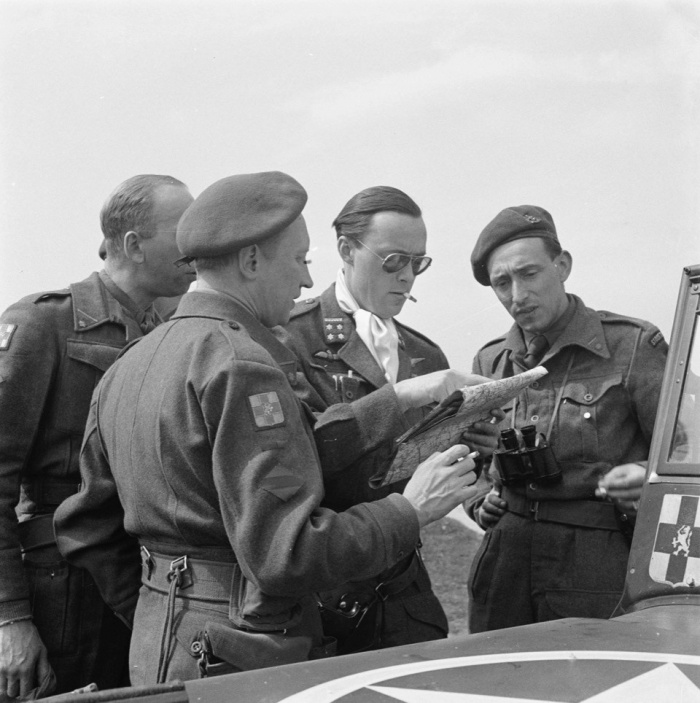
Breaking News
Their confidence was ill-founded. The next day two newspapers, the Daily Mirror from New York and the Washington Times Herald carried the INS news item almost without change, with the Washington paper adding a sensational headline:
Yanks Nab Dutch Prince Without Visa.
LONDON, Oct. 17. – Prince Bernard of the Netherlands, commander of the Dutch Army of National Liberation, was arrested by American Military Police for traveling without proper authorization along the front in Holland, well-informed sources in London said today. The prince, riding in a jeep, was accompanied by two women, one of whom was identified as Mrs. William Fiske, formerly the Countess of Warwick.
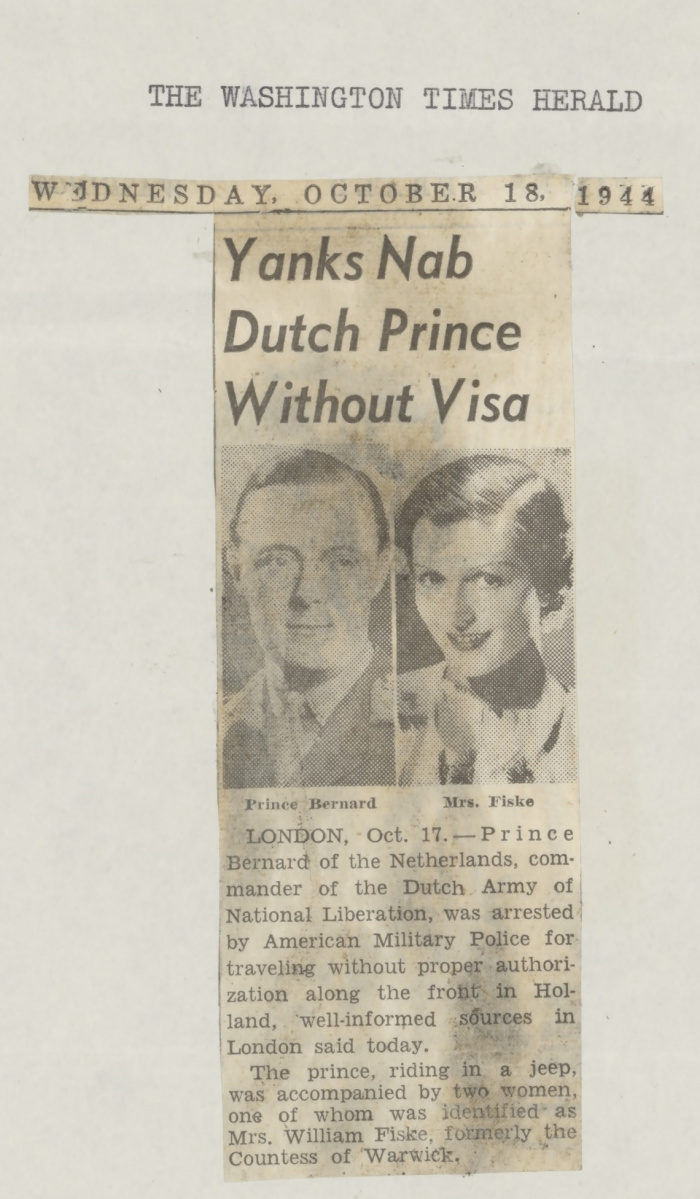
The Washington paper had added two photographs: one of Prince Bernhard and the other of a smiling young woman. Slotemaker was not pleased. He did not like the fact that the two newspapers had published the INS news item without any reference to the information supplied by the Dutch authorities. On the other hand major newspapers, such as the New York Times and the Herald Tribune, had not picked it up.
Yet the affair did not fail to catch the attention of other news outlets, which noticed the named passenger: “Mrs. William Fiske.” Who was she? Rose Fiske née Bingham had been married to Charles Greville, 7th Earl of Warwick. After her divorce, she married the American Olympic sportsman William (‘Billy’) Fiske, who joined the Royal Air Force as a fighter pilot and was killed in action in the Battle of Britain. In order to prevent reputational damage, Rose went public and in the London Weekly Dispatch furiously denied that she had taken part in such a ‘pleasure trip’. For the Prince and the Dutch government this was bad news, as Fiske’s denial could spread the word well beyond the two minor American papers.
As so often happens the attempts to keep the affair out of the media backfired, certainly in the long term. Who would pay any attention to it these days, if Slotemaker had not written his memo, extant in the National Archives of The Netherlands? And there is another set of records at the National Archives in Washington about Bernhard’s car trip in 1944. In a “Secret Memorandum”, the American diplomat James Webb Benton recounted “a very unfortunate incident” brought to his attention by Warrant Officer Rudy H. Finold. It concerned an encounter between Prince Bernhard and “an American sentry somewhere near the front; the Prince had insisted on travelling on a certain road which was closed to traffic and the American sentry had almost to use bodily force to prevent him from doing so.” According to Benton, Finold did not mention the presence of women. But he did relate that the incident was badly received at Allied Headquarters, as the American sentry had simply carried out orders. Benton added that Finold had told him that “there had been other incidents of an unfortunate nature but he could not recall them.”
Nevertheless, Slotemaker and his staff could heave a sigh of relief: the news hardly reached the Dutch communities in America and England and the Dutch in occupied territories remained oblivious to it. For them, Bernhard was and remained the German-born prince who had made the right choice when it mattered. According to an American intelligence report of November 1944, his popularity in the liberated provinces knew no bounds:
Prince Bernhard is extremely popular. He has the advantage of being the first and only member of the royal family to visit this area. Pictures of Juliana and Bernhard are numerous in the shop windows and in the homes in Eindhoven and Maastricht.
Clearly a faux pas or two could not harm the reputation of a prince in wartime.

About the author
Dik van der Meulen (PhD Leiden, 2002) is a well-known prize-winning Dutch author of literary non-fiction. He writes on ecology, history, and biography. His oeuvre includes biographies of the Dutch writer Eduard Douwes Dekker (Multatuli) and William III, King of The Netherlands (the father of Queen Wilhelmina), as well as works on the relations of the Dutch with their natural environment and the human interaction with wolves. His most recent work is Bernhard’s War: The Life of an Exiled Prince (Amsterdam: Querido, 2022).
About the blog series
This is the sixteenth installment in a monthly series of blogs telling stories about the rich history shared by the American and the Dutch peoples. Authors from both countries present accounts of their own choosing, from a wide variety of perspectives, in order to give as full a picture as possible of the triumphs and heartbreaks, delights and disappointments that happened over hundreds of years of shared history. Not all these stories are “feel-good history”, however. While the relations between the Dutch and the Americans have for the most part been stable and peaceful, their shared history contains darker moments as well. Acknowledging that errors have been made in the past does not diminish this friendship but, rather, deepens it.
Further Reading
- Graaff, Bob de, Dood van een dubbelspion. De laatste dagen van Christiaan Lindemans (‘s-Gravenhage: Sdu, 1987).
- Graaff, Bob de, Spion in de tuin. King Kong voor en na zijn dood (‘s-Gravenhage: Sdu, 1992).
- Meulen, Dik van der, Bernhards oorlog. Het leven van een prins in ballingschap (Amsterdam: Querido, 2022).
- Zijl, Annejet van der, Bernhard. Een verborgen geschiedenis (Amsterdam: Querido, 2010).
Sources
National Archives of the Netherlands:
- Collection 2.13.212, inv. nr. 63, documents relating to Christiaan Lindemans.
- Collection 2.05.80 (Ministry of Foreign Affairs, London archive), inv. nr. 5970 (documents relating to Prince Bernhard).
National Archives, Washington:
G 226 OSS, Entry NM-54 19-A: ‘Intelligence Reports (‘XL’Series) 1941-1946’. Folder XL 2606, box 30. Report on Prince Bernhard by OSS, November 1944. - RG 331, Entry 30, Box 4: Prince Bernhard to General W. Bedell Smith, 1 November 1944.
- RG 84, The Hague Embassy Confidential File, Box 4, J. Webb Benton, “Secret Memorandum”, 13 February 1945.
Illustrations
1. On October 1, 1949, Queen Juliana of the Netherlands unveiled the statue of “the mourning widow,” by Mari S. Andriessen, in remembrance of the Putten raid. The photograph shows the commemoration of 1956. (National Archives of the Netherlands, collection 2.24.05.02, inv. nr. 047-0698).
2. Prince Bernhard and General W. Bedell Smith in 1945 (National Archives of the Netherlands, collection 2.24.14.02, inv. nr. 255-8013).
3. Prince Bernhard and members of the Dutch government in exile saluting Queen Wilhelmina at her arrival on May 10, 1941 at Austin Friars Church in London for the service commemorating the Nazi invasion of the Netherlands (National Archives of the Netherlands, collection 2.24.26, inv. nr. 012-0070).
4. Prince Bernhard inspecting his Jeep after a collision in May 1945 National Archives of the Netherlands, collection 2.24.01.03, inv. nr. 900-2859).
5. Prince Bernhard deliberating which way to take, April 1945 (National Archives of the Netherlands, collection 2.24.01.03, inv. nr. 900-2494).
6. Newspaper cutting from the Washington Times Herald, October 18, 1944 (National Archives of the Netherlands, collection 2.05.80 Ministry of Foreign Affairs (London archive), inv. nr. 5970.
7. Prince Bernhard in his Jeep in April 1945, greeting a cheering crowd in a liberated part of the Netherlands (National Archives of the Netherlands, collection 2.24.01.03, inv. nr. 900-2562.
We hope you’ve enjoyed our articles and information. If you would like to contribute to help us promote and spread the history of the early New York, please click and discover more about our programs, what we offer and ways you can help.
To be a sponsor email us at: events@newamsterdamhistorycenter.org




